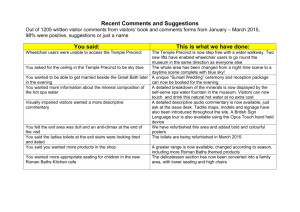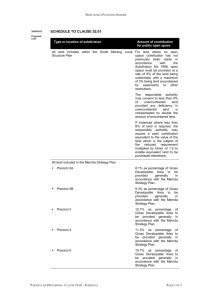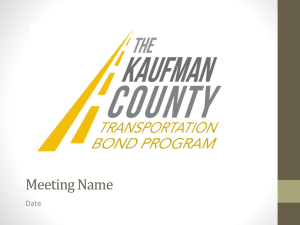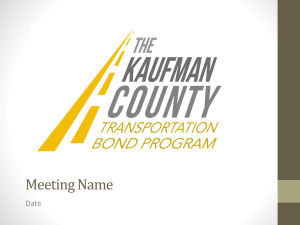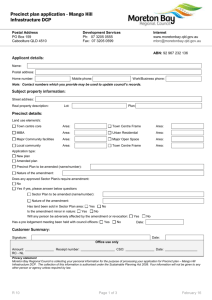West End - Woolloongabba District
advertisement
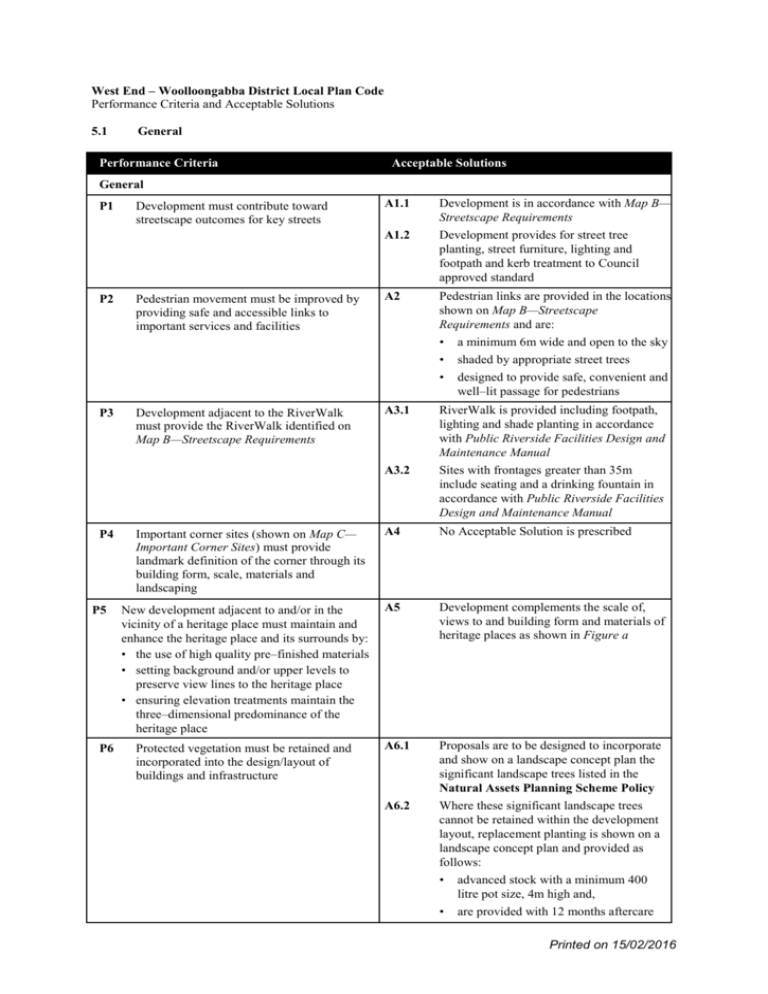
West End – Woolloongabba District Local Plan Code Performance Criteria and Acceptable Solutions 5.1 General Performance Criteria Acceptable Solutions General P1 Development must contribute toward streetscape outcomes for key streets A1.1 A1.2 P2 Pedestrian movement must be improved by providing safe and accessible links to important services and facilities A2 Development is in accordance with Map B— Streetscape Requirements Development provides for street tree planting, street furniture, lighting and footpath and kerb treatment to Council approved standard Pedestrian links are provided in the locations shown on Map B—Streetscape Requirements and are: • a minimum 6m wide and open to the sky • shaded by appropriate street trees • P3 P4 P5 P6 designed to provide safe, convenient and well–lit passage for pedestrians A3.1 RiverWalk is provided including footpath, lighting and shade planting in accordance with Public Riverside Facilities Design and Maintenance Manual A3.2 Sites with frontages greater than 35m include seating and a drinking fountain in accordance with Public Riverside Facilities Design and Maintenance Manual Important corner sites (shown on Map C— Important Corner Sites) must provide landmark definition of the corner through its building form, scale, materials and landscaping A4 No Acceptable Solution is prescribed New development adjacent to and/or in the vicinity of a heritage place must maintain and enhance the heritage place and its surrounds by: • the use of high quality pre–finished materials • setting background and/or upper levels to preserve view lines to the heritage place • ensuring elevation treatments maintain the three–dimensional predominance of the heritage place A5 Development complements the scale of, views to and building form and materials of heritage places as shown in Figure a A6.1 Proposals are to be designed to incorporate and show on a landscape concept plan the significant landscape trees listed in the Natural Assets Planning Scheme Policy Where these significant landscape trees cannot be retained within the development layout, replacement planting is shown on a landscape concept plan and provided as follows: Development adjacent to the RiverWalk must provide the RiverWalk identified on Map B—Streetscape Requirements Protected vegetation must be retained and incorporated into the design/layout of buildings and infrastructure A6.2 • • advanced stock with a minimum 400 litre pot size, 4m high and, are provided with 12 months aftercare Printed on 15/02/2016 Performance Criteria P7 Significant views must be retained Acceptable Solutions A7 Development within significant view windows and view sheds as shown on Map D—Significant Views maintain and enhance these views A1 Residents of Multi Unit Dwellings have 1 bicycle space per unit with visitor parking 1 space per 10 units Where in Precinct 4—Boggo Road P1 5.2 Adequate bicycle parking is provided to meet the needs of residents and visitors Precinct 2—West End Estate Performance Criteria Acceptable Solutions P1 Development must maintain the historic character and pattern of development of the precinct A1 No Acceptable Solution is prescribed P2 Pre–1946 buildings must be retained A2 Existing pre–1946 house/s are sited at the front of the site facing the street frontage P3 The subdivision and development pattern must present as small lots with narrow street frontages A3.1 Development does not straddle existing lot boundaries and lots are not amalgamated A3.2 Only one dwelling and no secondary dwelling is provided on each lot Setbacks must complement the setbacks prevailing in the street A4.1 The building footprint does not exceed 50% of the site area. Note: in calculating building footprint, measurements are to be taken from the outermost projections of all covered structures A4.2 Maximum building height is 2 storeys and 8.5m and 6.2m for rear and side eaves A4.3 The front elevation is a maximum of 4.8m above ground for a minimum of 65% of the front elevation. Refer Figure b Note: 1. Traditionally the verandah roof was approximately 2.1m at the edge. Any new ground floor should have a ceiling height of 2.4m to the street P4 2. Excavating under a house or a combination of raising and excavating is preferred to raising to achieve compatible scale and height A4.4 The house is set back from the front alignment (excluding eaves, awning, stairs) within 20% of the average setback of adjoining buildings fronting the same street A4.5 The front boundary of sites with two street frontages is the one that the majority of houses in the street front. The secondary street frontage is to comply with rear boundary requirements The side boundary setback of any new work A4.6 Printed on 15/02/2016 Performance Criteria Acceptable Solutions is a minimum of 1.5m A4.7 A4.8 A4.9 A4.10 A4.11 P5 Built form and scale in accordance with Figure c A5.1 The rear boundary set back is a minimum of 6m New building work for corner sites is set back a minimum of 1.5m along the longer frontage Roof pitch is a minimum of 26.5º Any ground floor is recessed a minimum of 2m from the front building line of the level above There are no built to boundary walls New building work is the same form and scale as surrounding character houses and is not pseudo–historic replication. In accordance with Figure c, elevational compositions of entries and verandahs, car accommodation and roof shape conform to the overall street pattern Note: 1. Mono pitch and skillion roofs to the street are not appropriate 2. Contemporary detailing is restricted to the rear of the dwelling 3. Roof forms should be pyramidal with side front gable or transverse gable only 4. Street elevations are composed of full– length verandahs or combination of projecting gabled room with verandah. Verandahs may be enclosed if they retain a lightweight transparent appearance and are capable of being reversed. Refer to Figure c P6 Buildings must use the same lightweight materials that are used in pre–1946 houses nearby in the street A5.2 The first floor is accessed by external stairs on the front elevation A5.3 Front fences are a maximum height of 1.2m with timber paling or wire A6 New building work is constructed of traditional materials most commonly used in pre–1946 houses in the precinct Note: traditional materials are painted timber walls and corrugated metal roof sheeting P7 Off street carparking behind the existing building line A7.1 On–site carparking, if not existing, is not required A7.2 Garages or carports are not located between the front elevation and the front boundary and are: • located a minimum of 2m behind the building line • a maximum width of 3m A7.3 Other carparking is single width only and is recessed 2m behind the building line. Refer Printed on 15/02/2016 Performance Criteria Acceptable Solutions Figure b A7.4 Driveway cross over width is a maximum of 3m P8 Maximising outdoor green space must be maximised and mature trees retained consistent with the traditional backyard pattern of the precinct A8 Established trees are retained where removal is not required to site new work P9 New work must be protected from adverse flooding and must not significantly interfere with the passage of, storage, or quality of stormwater or the natural functions of a waterway A9 Design and construction of the new work complies with Council’s Erosion and Sediment Control Standard P10 Habitable rooms, non–habitable areas (e.g. utility areas, garage, laundry and storage room) must have acceptable levels of flood immunity A10.1 Where the lot is subject to a resolution about minimum floor levels of habitable rooms under the Standard Building Regulations 1993, the floor level satisfies the level determined in the resolution OR Where the house is on floodable land but the lot is not subject to a resolution about minimum floor levels of habitable rooms under the Standard Building Regulations 1993, the floor level of all habitable rooms is not less than those set out in Table 1— House Flood Immunity Levels in the House Code Where lot is on floodable land, the minimum levels for non–habitable areas (including utility areas, garage, laundry and storage room) are not less than those set out in Table 1—House Flood Immunity Levels in the House Code A10.2 P11 5.3 Direct overlooking between buildings must be minimised by building layout and design of windows and balconies or screening devices A11 Where the proposed new work is within 2m at ground level or 9m above ground level of an existing house (refer Residential Design—Small Lot Code, Figure u), windows of habitable rooms with an outlook to habitable room windows in an adjacent house have screening in accordance with Residential Design—Small Lot Code, Acceptable Solution A12 Precinct 2—Mater Hill Performance Criteria Acceptable Solutions Where in Sub–precinct 12(a) P1 Development must be of a medium rise high density form that provides a transition from sub–precinct 12(c) to Vulture Street and maintains the predominance of the Mater Hospital A1.1 A1.2 A1.3 Minimum site frontage is 25m Minimum site area is 1000m2 Maximum GFA is 2 times the site area A1.4 Maximum building height is 6 storeys and 20m A1.5 Buildings are set back a minimum of 6m Printed on 15/02/2016 from the rear boundary P2 • • • • A2.1 Development fronting Stanley Street must: reflect the traditional commercial character of the street provide vehicular access to sites on the southern side of Stanley Street only via A2.2 Graham Street comprise vehicular access that improves safety A2.3 and alleviates traffic impacts maintain an active street frontage A2.4 Development is built to the street frontage and provides a 3 storey parapet with levels above 12m set back 3m in accordance with Figure d, and a continuous awning to the street Vehicular access is not directly from Stanley Street Vehicular access is consolidated in accordance with vehicle routes on the Centre Concept Plan Map E—Mater Hill Precinct Vehicle parking including visitor and tenant carparking, refuse collection manoeuvring and refuse storage areas are not visible from the street A2.5 A retail or commercial use is maintained on the ground storey A2.6 Development incorporating mixed uses has separate entries within 2m of the front boundary for the residential and non– residential components of the building as shown in Figure a A3.1 A3.2 A3.3 Minimum site frontage is 20m Minimum site area is 800m2 Maximum GFA is 2 times the site area A3.4 Maximum building height is 6 storeys and 20m A3.5 Building setbacks to side boundaries not fronting a street are a minimum of 3m A4.1 The ground floor of buildings is to include a minimum of one (1) unit that is designed to be adaptable to the requirements of Australian Standard AS4299, Adaptable Housing, Class C and Housing Queensland’s Universal Housing Design. Refer to Figure e A4.2 All external pathways, entrance foyers and entrances to all units within the development are provided in accordance with Australian Standard AS1428 Design for Access and Mobility A5.1 Maximum building heights are in accordance with the Centre Concept Plan Map E—Mater Hill Precinct A5.2 Carparking, servicing and recreational facilities are set back a minimum of 6m from any boundary adjoining a residential use or school external to the sub–precinct and is landscaped with deep planting to provide a visual buffer The building form is staggered to reduce Where in Sub–precinct 12(b) P3 P4 Development must be a medium rise medium density residential form with building height limited to minimise overshadowing impacts to adjoining educational users and maintain the predominance of the Mater Hospital Multi–unit dwellings must be easily adaptable to the needs of people with disabilities Where in Sub–precinct 12(c) P5 The siting, scale, appearance and design of development must be respectful of the adjoining schools and residential uses to reduce overshadowing, traffic and servicing impacts A5.3 Printed on 15/02/2016 overshadowing of habitable areas or significant open spaces on neighbouring sites P6 Development adjoining a heritage place, the heritage area or within the heritage area, must respect the heritage setting landscape as defined in the heritage place citation, in terms of building setbacks, heights, materials and design A6.1 A6.2 Heritage places in the heritage area and views shown on the Centre Concept Plan Map E—Mater Hill Precinct are maintained and enhanced, consistent with an approved conservation plan Development: • is contemporary in form and detailing so as to complement the heritage places • maintains views shown on the Centre Concept Plan Map E—Mater Hill Precinct provides a suitable transition to the scale, materials and height of the heritage places and protects significant vegetation • • A6.3 minimises overshadowing of the heritage places Development along Annerley Road: • • • P7 The building design and materials must be of a high quality to respond to the importance of the building as a major health facility that is highly visible from a number of key transport routes and the surrounding area Pedestrian paths must be easily identifiable and well planned to connect important nodes of the hospital with surrounding services and facilities, such as the Busway ensures that vehicular access does not impact on the wall or stairs A6.4 Any development of the former Mater Children’s Hospital maintains the building footprint and building scale which is symmetrical with the location of the stairs from Annerley Road A7.1 Development built to the Stanley Street frontage provides a continuous awning to the street and a four storey parapet with levels above 16m set back 3m in accordance with Figure f A7.2 Elevations are articulated using colour, texture, materials (including face brick), setbacks and architectural features to reduce visual bulk and complement the heritage place in the precinct Roof shapes, parapets and overall building forms add to the visual distinction of the hospital, including when viewed from a distance A7.3 P8 maintains the stairs as an important access to hospital facilities is set back from Annerley Road to the building line of the 1931 Mater Children’s Hospital A7.4 Vehicle parking including visitor and tenant carparking, refuse collection, manoeuvring and refuse storage areas are not visible from the street A8.1 Key access points as shown on the Centre Concept Plan Map E—Mater Hill Precinct are enhanced through any development A8.2 Development provides safe, legible and accessible pedestrian circulation between Printed on 15/02/2016 hospital facilities, street level, drop–off zones, carparks and public transport in accordance with the Crime Prevention Through Environment Design (CPTED) Planning Scheme Policy P9 Major traffic generating uses must have vehicular access to the surrounding major roads to minimise traffic impacts on nearby residential streets P10 Development of the hospital must minimise impacts to residential uses fronting Clarence Street A9.1 Major traffic generating uses are located north of the heritage area and fronting Stanley Street and have consolidated access to Stanley Street, Vulture Street, or Raymond Terrace A9.2 Access to Annerley Road is safe and efficient A9.3 No vehicular access to and from major traffic generating uses in the hospital is provided via Clarence Street A10 Development: • • P11 • • • • • 5.4 Development built over roads must: provide for safe vehicular traffic movements provide for pedestrian safety create a high quality streetscape amenity in terms of building form and detailing, lighting, materials and landscaping be designed to minimise the visual bulk and scale of the structure maximise solar access to the street A11 provides a landscaped setback of a minimum of 6m from the street frontage is a maximum of 3 storeys in height for a depth of 20m • incorporates design elements and materials that are in character with the residential uses fronting Clarence Street • minimises overshadowing of habitable rooms in residential buildings on the southern side of Clarence Street • does not include direct access to Clarence Street Development over Stanley Street: • is for pedestrian and service access only • has a minimum 80% transparency • has clearance to allow the continued safe use of the road by all vehicles • limits the width of the building over the road provides lightwells at a maximum spacing of every 8m • • provides high quality cladding and sculptural treatments to the underside of buildings located over roads • provides pedestrian lighting for both daytime and night–time use • provides for street tree planting, street furniture, lighting and footpath and kerb treatment to Council approved standard Precinct 3—Transit Oriented Performance Criteria Acceptable Solutions P1 A1 Development must be well planned and provide: • a mixture of residential and commercial uses Development is in accordance with an approved Structure Plan which provides: • a useable and attractive public space Printed on 15/02/2016 • a landmark design • safe and convenient connections and access to surrounding services and facilities • development over the Woolloongabba Busway Station layover area • a landmark building form which addresses the high visibility of the site from the South–East Freeway, Ipswich Road and Vulture Street • convenience retail uses that reinforce the centre activities along Stanley Street high density residential uses with a site layout and design that address amenity issues from the major sporting and transport facilities and road networks • • • 5.5 improved pedestrian and cycle connections to the Woolloongabba Centre East, Brisbane Cricket Ground and Busway Station low cost housing Precinct 4—Boggo Road Performance Criteria Acceptable Solutions P1 A1 • • • • Development must be of a medium density form, which: complements the character of the locality provides integrated transport solutions provides accessible parkland avoids increased traffic volumes in adjacent residential streets Development is in accordance with an approved Structure Plan that: • provides a maximum of a medium rise form • maintains the setting of heritage places in accordance with an approved conservation plan • contains high quality public parkland and community facilities that are easily accessible for residents living in and around the precinct creates a safe pedestrian environment to facilitate easy pedestrian and cyclist access to, through and within the precinct, in accordance with the Crime Prevention Through Environment Design (CPTED) Planning Scheme Policy maximises access to and use of local public transport nodes and parks • • • provides vehicle access to the site only from Annerley Road While every care is taken by Brisbane City Council to ensure the accuracy of this extract of the code, Council make no representations or warranties about its accuracy, reliability or completeness and disclaim all responsibility and all liability (including without limitation, liability in negligence) for all expenses losses and damages (including direct and consequential damage) and costs that may be incurred as a result of the document being inaccurate in any way and for any reason. Printed on 15/02/2016

